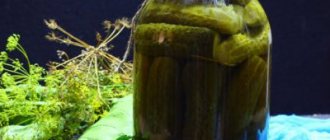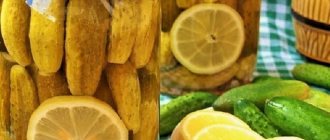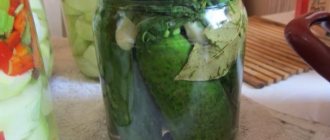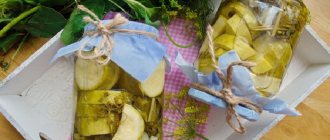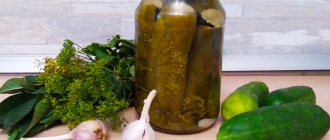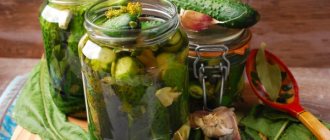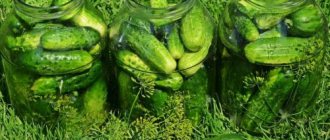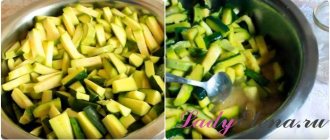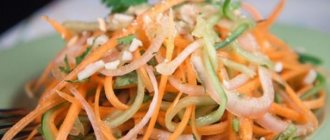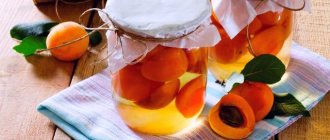There are many ways to prepare cucumbers for the winter. But the main ones are salting, fermentation and pickling. Everywhere has its own nuances, and let's try to consider some of them.
Those that do not require special knowledge and skills, but only the desire to eat in winter something of which you are 100% sure of the quality and usefulness. When you know that the products on your table do not contain numerous “E” numbers and all kinds of titanium dioxides as preservatives.
Attention: to avoid voids in the cucumbers, choose young cucumbers and be sure to soak them for 3-4 hours in cold water. If the water is hot, add ice (otherwise the cucumbers may begin to ferment before canning), or simply replace the water with fresh water.
A signature feature of pickled cucumbers is cloudy brine. So don't let its cloudiness bother you.
When using winter garlic, which is more “evil”, its quantity is 20-25% less than spring garlic. A sign of winter garlic is the presence of a central tree-like core.
Pickled cucumbers in jars for the winter - a recipe for crispy cucumbers without sterilization
Let us remind you: heat treatment of such cucumbers is still carried out, but it cannot be called sterilization. Boiling the infused brine will, rather, be a way to stop the fermentation process so that it does not go too far and does not give excess sourness to the finished cucumbers.
Recipe ingredients required:
- Fresh cucumbers – 3 kg;
- Filtered tap water – 2 liters;
- Dill umbrellas with stems – 5-6 pcs;
- Leaves of cherry, horseradish, black currant - to taste;
- Garlic cloves – 2-3 pcs;
- Bay leaf – 3-4 leaves;
- Salt at the rate of 2 full tablespoons per 1 liter of water.
In addition, you must have a battle-ready arsenal of:
- Cloth potholders;
- Containers for fermentation;
- Containers for boiling infused brine;
- Glass jars
- Covers for them
- Towel
- Seaming machine (in case of using simple lids with a rubber gasket)
Preparation:
1. Place bay leaves, cherry leaves, currants and garlic at the bottom of the container prepared for fermentation;
2. Place cucumbers on top, fill with water so that there is 6-8 cm of free space left to the top of the container;
3. Pour salt into the water prepared for pouring cucumbers. Stir well until it is completely dissolved. Pour salted water over the cucumbers, leaving 3-4 cm of space up to the edge for the brine to rise during the fermentation process, place horseradish leaves on top, cover with a large flat plate or wooden circle, and apply pressure;
4. Keep at room temperature until cloudy and foam forms. The signal to stop the process should be the cessation of foaming. After this, the cucumbers are kept in a container for another day to guarantee, the brine is poured into another pan and set to boil;
5. While the brine is boiling, scald the cucumbers with boiling water in the same container where they were fermented.
6. Transfer the cucumbers into sterilized jars, pour boiling brine over them, let stand without rolling them up, just covering them with lids, for 5-6 minutes, then pour the brine back into the pan, boil again, pour them into the jars with cucumbers and quickly roll them up. Before the second filling, add up to 1 teaspoon of mustard seeds and 2-3 clove seeds to each jar.
An indicator of the correctness of all the operations performed will be the gradual clarification of the initially cloudy brine - all the cloudy sediment will be at the bottom.
Secrets of making crispy pickled cucumbers
There are some secrets to proper salting. If you know them, you can get pickled cucumbers that will surprise everyone without exception. They consist of the following:
- Under no circumstances should you use tap water in the brine; it will ruin the taste of the product and turn the vegetables into a mush. It is best to purchase bottled for this case.
- Iodized salt and extra-class salt are not suitable for salting. They contain strong poison in the form of sodium and potassium ferrocyanides.
- The most delicious cucumbers are obtained in oak barrels, since the wood gives the vegetables its subtle aroma - glass and plastic containers cannot do this.
- For pickling, it is better to take young cucumbers; all fruits should be the same size. In addition, they should not be damaged, dents, or cuts. Ideally, you should select varieties with white pimples. Experienced housewives claim that they are most suitable for pickling.
- To prevent mold from forming in jars of vegetables, it is necessary to add mustard powder to the marinade during the procedure. You can simply grease the inside of the metal lids with mustard - this gives the same effect.
- Sealing jars with metal lids ensures longer storage than other options. Under proper conditions, the product will retain its taste for at least 1 year, naturally in a closed state. If the container is opened, then it is necessary to consume the cucumbers as quickly as possible, so for pickling it is better to take 1-liter containers.
- If, during storage, swollen lids are found or obvious signs of leakage are noticeable, then you should open and boil the brine again three times, and then close in the usual way. But, as a rule, if all the rules are followed, such troubles should not arise.
These simple secrets will help you pickle cucumbers that are perfect in taste, aroma and appearance. The main thing is to decide on the method of preparing pickled cucumbers, process the dishes correctly, and monitor the accuracy of the dosage.
Crispy cucumbers for the winter under a nylon lid
At the first stage, a tub, bucket or basin is used so that you can cover it with a lid and press it with pressure. In the future, you can transfer it to well-washed or sterilized glass jars.
What products will be needed:
- 2 kilograms of cucumbers
- 3 tablespoons “Extra” or rock salt (without iodine)
- 4-5 garlic cloves
- Large horseradish leaf
- 2-3 dill umbrellas
- Black peppercorns to taste
- One and a half liters of water
And prepare nylon covers, the so-called “double” ones. They have a deep side and are put on the neck of the jar only when heated with boiling water. They do not provide complete sealing, but it is not necessary - escaping carbon dioxide from under the lid is even desirable; pickled cucumbers should “breathe”.
Preparation:
1. Rinse the cucumbers pre-soaked in cold water and dry on a towel. Trim a little from both ends - this will give better and even salting, and taste the cut ends for possible bitterness;
2. Place garlic, dill umbrellas and peppercorns on the bottom of a fermentation container scalded with boiling water;
3. Place cucumbers;
4. Top with horseradish leaves and salt;
5. Pour cold water over the cucumbers...
... and cover with a lid
Shake the jar until all the salt dissolves
6. Keep the cucumbers in this state for up to 6 days. Remove the lid, use a slotted spoon or spoon to catch all the foam, transfer the cucumbers to jars, discard the dill and horseradish. Pour cloudy brine and seal the jars with lids heated in boiling water;
7. Keep at a temperature from 10 to 18⁰С.
Preparing the container and ingredients
Glass jars are chosen for pickling. The container must be solid, without cracks or scratches. During the cooking process you will need plates, a basin, forks and knives. All kitchen utensils must be clean. Close the jars with nylon lids.
The cucumbers should be uniform in size, firm and crispy. Cooks choose varieties with pimples - the dishes turn out more juicy and tasty. Before fermentation, they are soaked in cold water for two hours. Greens and other vegetables are washed under cool water and wiped dry. Before cooking, check the expiration date of spices and herbs.
Cucumbers for the winter, pickled in jars with mustard
These cucumbers taste like barrel cucumbers. Mustard for them is taken not by seeds, but in the form of mustard powder. In order not to add turbidity to the brine, it is better to place mustard powder in a tightly tied linen bag at the bottom of each jar.
The quantity of products is taken into three three-liter jars by volume. Although, given the use of oppression in this type of fermentation, for the process itself it is better to take a wooden tub or a bowl made of food-grade plastic. In the future, if you want, for convenience, you can transfer the already fermented cucumbers into jars of the required volume.
Ingredients:
- Fresh cucumbers – 4 kilograms;
- Filtered drinking water – 3 liters;
- Table salt – 200 gram glass without a slide;
- Garlic – 12-15 medium-sized cloves;
- Dill umbrellas – 10-12 pcs;
- Horseradish leaves – 10 pcs;
- Oak and/or black currant leaves – 12-15 pcs;
- Mustard powder – 3 tables. heaped spoon.
Procurement process:
1. Soak the cucumbers for 3-4 hours in cold water. Finally, rinse and dry on a towel;
2. Place the pickling ingredients in a pickling container in layers, alternating cucumbers, dill, spices, etc.: The linen bag is placed at the very bottom, first, in the approximate geometric center of the container;
3. Well-washed horseradish leaves are placed last, on top;
4. Dissolve the salt thoroughly, without any residue, in cold water, pour over the prepared layers;
5. Cover the poured workpiece with a large inverted flat plate and press down on top with a weight. This could be a jar filled with water.
6. Leave it like this in a secluded shaded place in the apartment, at room temperature, for 4-5 days. The brine should become cloudy to the extent of heavily diluted milk.
7. After this, you can take a sample, arrange the cucumbers along with spices in a storage container, place them in the cellar, basement or on the bottom (not freezer) shelf of the refrigerator.
If there was a white coating on the cucumbers, scald them with boiling water, cool, and store them cold. If there was foam in the brine, leave it to ferment for another 8-10 hours. The presence of foam indicates that the fermentation process has not been completed.
Cold pickled cucumbers for the winter
This method of preservation (without sterilization or even heating) is similar in process to sauerkraut, only it takes less time and does not require large volumes of preparations.
The amount of ingredients is based on 1 three-liter jar of cucumbers.
What is needed for fermentation
- Fresh cucumbers – 1.5 kg
- Medium-sized horseradish leaves – 3 pcs.
- Cherry leaves 5-6 pcs;
- Dill umbrellas – 3 pcs.
- Garlic – 4 cloves;
- Rock salt – 3 tables. heaped spoons;
- Hot peppercorns - to taste (usually 4-5 peas)
Do not overload the garlic and pepper! Their excess will interfere with fermentation.
Preparation:
1. Wash the cucumbers carefully after soaking, without damaging the peel. You can trim the ends just a little;
2. Wipe the washed cucumbers dry with a towel;
3. Place cucumbers, herbs and spices in layers in a three-liter jar;
4. Dissolve the salt in approximately 750 ml of drinking water (if you are not sure about the quality of tap water, pass it through an ion exchange or silver filter);
5. Pour the saline solution over the cucumbers in the jar, add regular water to the top, cover with a lid and vigorously turn the jar several times so that the salt is dispersed evenly in the solution.
Now you need to wait for the natural process of fermentation of the brine and cucumbers in it to begin. It is somewhat similar to when the brine in a jar of hot-rolled pickled cucumbers becomes cloudy. But there this clearly means damage to the product. Here it only indicates fermentation.
Jars should be kept at room temperature. Then, by about 4-5 days, the brine will become cloudy, and in this form, the jars, without closing, should be put in a cold place with a temperature of 8-12 degrees. Add water to the jars periodically to keep them full.
Storage Features
Store the workpieces at temperatures from 0°C to +4°C. It is not recommended to leave them in the room - the fermentation process occurs in the heat, and the vegetables quickly peroxidize. If there is a cellar or basement, cucumbers are stored there. If not, place it in the refrigerator.
The jars must be closed with iron or nylon lids. Cucumbers can be stored in glass jars for 1-2 months. Grated horseradish or sugar will help extend the shelf life - these ingredients are added to the finished snack.
Recipe for pickled cucumbers in a jar with an iron lid
The most not even democratic, but anarchic recipe, in which spices for cucumbers are recommended “whatever you want and as much as you want.” Complete freedom of expression! And this recipe is a champion for fermenting cucumbers in its simplicity and accessibility. But its simplicity requires strict adherence to the recommendations, in particular, good washing of the fermentation components.
Boiling already fermented brine is not sterilization. This is simply a way to remove unnecessary microorganisms that participated to the best of their ability in the fermentation process.
Storing cucumbers fermented according to this recipe is possible even in a city apartment - if it is heated without fanaticism, and the temperature in winter is kept between 21-23 degrees.
Ingredients:
- The very “anarchist kit” that suits your taste. May include horseradish leaves and root, cherry, blackcurrant, oak and even young birch leaves (I tried it, wow!), mustard seeds, dill or fennel umbrellas, garlic cloves, coriander (cilantro seeds) - to taste and preferences;
- Cucumbers – 3 kg;
- Well water, artesian water, filtered or boiled and cooled from the tap – 2.5 l;
- Non-iodized, rock or “Extra” salt - at the rate of 1.5 tablespoons per liter of water.
How to cook:
1. Cucumbers and other ingredients are placed layer by layer into a convenient container with a wide neck (bucket, basin, tub);
2. Salt is diluted in water and the contents of the container are poured in such a way that, crushed under pressure, it is completely hidden under the brine. Remember that during fermentation, the brine level rises during the process, so leave a margin of 4-5 cm to the edge of the container;
3. After 4-6 days of standing at room temperature in a shaded place, remove the cucumbers from the bucket, remove the foam and discard, rinse the cucumbers in warm salted water (salt concentration is the same as in brine), place on a clean towel;
4. Boil the brine for 2-3 minutes in a saucepan and, while boiling, pour the cucumbers placed in jars;
5. Keep it like this, covered, but not rolled up, for 5-6 minutes, pour the brine back into the pan, boil again, pour into jars and quickly roll up.
Such a workpiece can stand at room temperature for an unlimited time. At least a year - for sure! If a non-hermetic seal is used, and, say, a nylon lid with a hot fit on the neck, then it is better to store such jars in a basement, cellar, or simply in any cool place.
Afterword. Briefly about the main points and principles of pickling cucumbers:
Fermentation is a biochemical process when lactic acid is formed as a natural preservative in the containers where fermentation occurs. The same one that is present in sauerkraut.
City dwellers, accustomed to buying pickled cucumbers, rolled up in sterile jars, have, in their overwhelming majority, become unaccustomed to such an original Russian dish. But in vain! Pickled cucumbers (as well as lightly salted cucumbers) are much healthier and simply tastier if they are prepared with soul and correctly.
Buy a couple of these cucumbers at the market. Give it a try. Ask the sellers how they did it - and go ahead, make your own homemade preparations!
And - general advice to everyone who practices canning vegetables from their garden at the dacha or purchased during the season (they are minimal in price at this time): get yourself a wooden (preferably oak) tub with a volume of 8 or more liters! Highly recommended!
It will not take up much space, even in a city apartment (there is always a balcony, mezzanine or chest in which it can be stored, and in the off-season you can store all sorts of things, even inedible ones), and for fermentation at the first stage, be then peppers, cucumbers or cabbage will be very useful! In plastic or enamel dishes, fermentation is not always successful.
Author of the publication
offline 24 minutes
